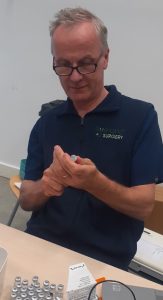 Crispin Fisher is a full time GP partner in Herefordshire. Now the wrong side of 6o, and still enjoying the role
Crispin Fisher is a full time GP partner in Herefordshire. Now the wrong side of 6o, and still enjoying the role
The future of GP Partnership has been much in the news of late, and with a possible change of government next year there may be further scrutiny of its relevance to primary care. The recent need to identify and appoint new partners (fortunately successfully) at my own practice prompted me to look back on my 25 years as a GP partner and to try to distil what being a partner actually entails. The resulting list could both deter or encourage GPs contemplating partnership, but it should help them to consider the role from a more informed perspective. What we can aver is that being a GP partner is an exciting and challenging job, with many benefits and responsibilities. No doubt others will want to add to, or subtract from, the list.
Key functions and roles of a partner include:
Strategy/Leadership
• Vision – for the future of the practice, the local health community and the wider NHS
• Long-term commitment
• Continuity (for the practice)
• Defining & implementing strategy
• Leadership
• Future planning & service development
• Carrying risk and sharing rewards
• Identifying, and embracing, opportunities
• Building a team
• Maintaining morale
Clinical
• Clinical leadership – protocols, policies, Patient Specific Directives (PSDs)/Patient Group Directions (PGDs), setting clinical priorities etc.
• Quality and Outcomes Framework (QOF)
• Direct Enhanced Services (DES’s), Local Enhanced Services (LES’s), Clinical Excellence and Investment Framework (CEIF), Investment and Impact Fund (IIF) and other contractual commitments
Governance
• GP Contract – meeting all requirements
• Care Quality Commision (CQC), including preparation for inspections
• Health & Safety
• Clinical Governance
• Caldicott Guardianship
• Corporate Governance
• Complaints
• Safeguarding
• Keeping abreast of, and actioning, guidance and directions from NHS England (NHSE), Integrated Care Board (ICB), CQC, Medicines and Healthcare Products Regulatory Agency (MHRA) etc.
Staff
• Staff well-being
• Staff planning
• Recruitment
• Appraisals
• Disciplinary issues
• Inductions
• Disputes
• Tutoring staff (e.g. independent prescribing course)
• Rotas
• Social events
Training/Research
• Training – registrars, Foundation Year (FY) doctors, student nurses, Physician Associates (PAs), Additional Roles (AR) staff etc.
• Tutoring medical students
• In house education
• Research
Finances/Estate
• Ownership
• Financial investment in, and commitment to, the practice
• Carrying (financial) risk and sharing (financial) rewards
• Finances/accounts
• Buildings
• Equipment
• Security
• Working for new premises, if required
Other
• Covering gaps in service, often at very short notice!
• Crisis management, e.g. Covid-19
• Local Medical Committee (LMC), including meetings
• Primary Care Network (PCN), including meetings
• ICB – links and collaboration
• GP Federation – representation/meetings
• Dispensary/dispensing
• Patient Participation Group (PPG)
• Communications – website, newsletter, Facebook etc.
• Hands-on manual work – clearing, moving furniture, re-organising, etc.
Like marriage, it is not by any to be entered into unadvisedly or lightly! Also like marriage, partners have to get along well and support each other, with tolerance, understanding and commitment. Despite its long list of duties and responsibilities, it can, and does, bring huge satisfaction.
Featured image by Hans-Peter Gauster on Unsplash






